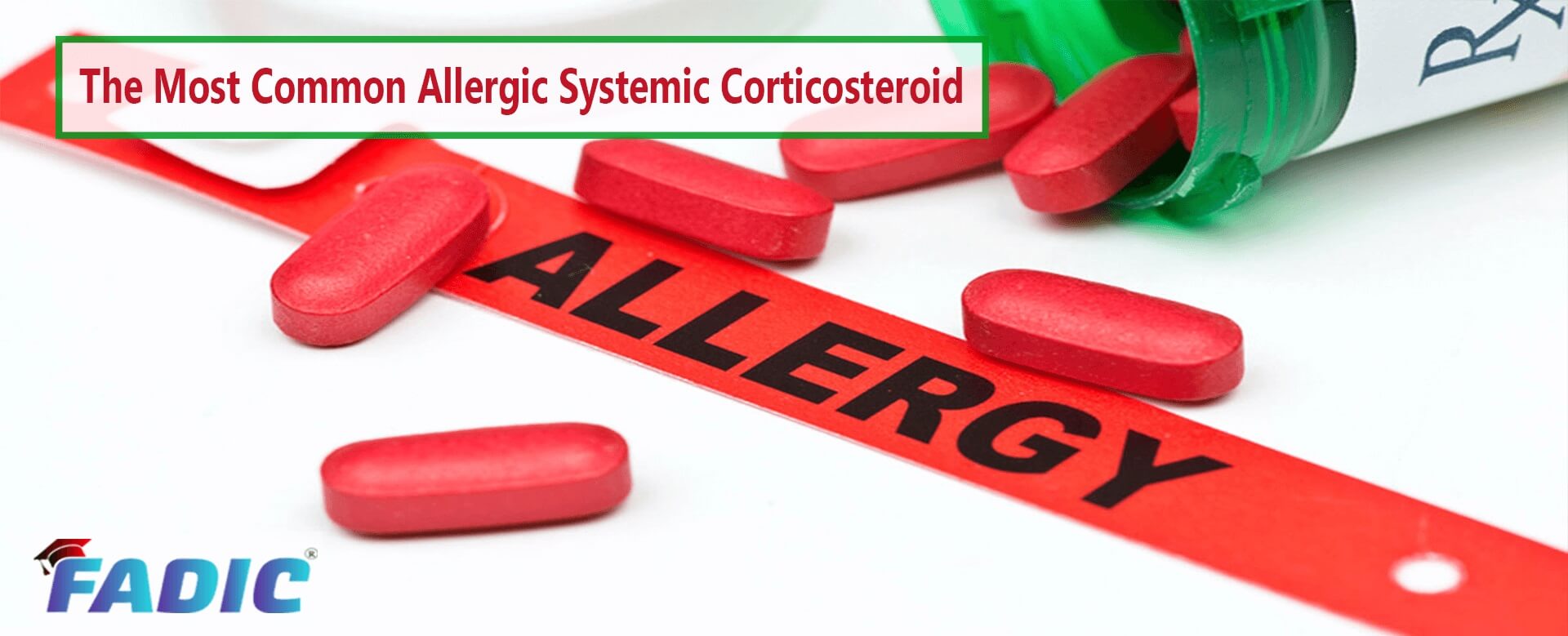Corticosteroids Common Drug List, Side Effects
Corticosteroids Common Drug List, Side Effects
The Most Famous drug most Commonly used in the Control of severe or incapacitating allergic conditions “Corticosteroids.”
1- PrednisoLONE 💊
2- HydrocortiSONE 💊
3- MethylprednisoLONE 💊
4- TriamcinoLONE 💊
5- DexamethaSONE 💊
6- BetamethaSONE 💊
7- MometaSONE 💊
PrednisoLONE
- Brand Names: Prednisolone
- Therapeutic Category: Corticosteroids, Systemic
- Dosage Forms: Solution, Oral/ Tablet, Oral
- Use: Labeled Indications: Control of severe or incapacitating allergic conditions / Dermatologic diseases/ Endocrine disorders/ Hematologic disorders/ Neoplastic diseases/ Nervous system/ Ophthalmic diseases
- Off-Label Indication: Alcoholic hepatitis/ Asthma exacerbation/ Chronic obstructive pulmonary disease (COPD) (acute exacerbation)
- Dosing : Adult: Usual dose (range): Oral: 5 to 60 mg/day
- Pediatric: Dose depends upon the condition being treated and the response of the patient
- Infants: Oral: 2 mg/kg/day divided twice daily for 5 days, followed by 1 mg/kg/day once daily for 3 days, followed by 1 mg/kg/dose every other day for 3 doses
- Dose Adjustments
- Renal Impairment. No dosage adjustments of Corticosteroids
- Hepatic Impairment: no dosage adjustments of Corticosteroids
- Adverse Drug Interaction:
Cardiac failure, cardiomyopathy, oedema, facial oedema, hypertension, Headache, insomnia, malaise, myasthenia, nervousness - Pharmacodynamics/Kinetics:
- Duration: 18 to 36 hours
- Half-life elimination: 2 to 4 hours
- Time to peak plasma: 1 to 2 hours
- Important Notes: It may cause osteoporosis (at any age) or inhibition of bone growth in pediatric patients. Use with caution in patients with osteoporosis
- Pregnancy & Lactation: Pregnancy Risk Factor C/D/ present in breast milk.
- Drug Safety Issue: PrednisoLONE may be confused with predniSONE
- Pediapred may be confused with Pediazole
- Prelone may be confused with PROzac
Highly Recommend this Hydrossential Serum: Amazing for your Skin
HydrocortiSONE
- Brand names: Alcortin , Cortizon-10.
- Therapeutic category: Corticosteroids, systemic & Topical.
- Dosage forms: solution/ oral, solution-drops/ Otic, solution-drops /Ophthalmic, lotion – cream – ointment- Gel / topical, injection intramuscular and intravenous.
- Use – Labeled indecations: Control of severe or incapacitating allergic conditions / Dermatologic diseases/ Endocrine disorders/ Hematologic disorders/ Neoplastic diseases/ Nervous system/ Ophthalmic diseases/ Gastrointestinal diseases/ Rheumatic Disorders.
- Use – Off labelled indications: COVID-19, hospitalised patients (severe or critical); In-hospital cardiac arrest; Septic shock; Thyroid storm.
- Dosing : Adult: Usual PO dosing range: 10-320 mg/day divided q6-8hr.
- Pediatric & infant: Monitor for symptoms of under and/or overtreatment, including signs and symptoms of adrenocortical insufficiency, linear growth and weight gain; adjust doses accordingly
- Inflammation: <12 years: 2.5-10 mg/kg/day PO divided q6-8hr or 1-5 mg/kg/day IM/IV divided q12-24hr.
- Status Asthmaticus: 1-2 mg/kg IV q6hr for 24 hr; not to exceed 250 mg
- Renal Impairment: no dosage adjustments of Corticosteroids; use with caution.
- Hepatic Impairment: no dosage adjustments of Corticosteroids; use with caution.
- Adverse Drug Interaction: Acne, Adrenal suppression, Arthralgia, Bladder dysfunction, Cushing syndrome, Cardiac failure, cardiomyopathy, oedema, facial oedema, hypertension, Headache, insomnia, malaise, myasthenia, nervousness.
-
Pharmacokinetics
- Absorption: Bioavailability: PO, 96%
- Duration: Short-acting
- Distribution: Protein-bound: 90%
- Vd: 34 L
- Metabolism: Metabolized in tissues and liver
- Metabolites: Glucuronide and sulfates (inactive)
- Half-life: Plasma, 1-2 hr; biologic, 8-12 hr
- Excretion: Urine (mainly), faeces (minimally).
- Important notes: contraindicated in Untreated serious infections (except tuberculous meningitis or septic shock)
- Idiopathic thrombocytopenic purpura (IM administration only)
- Intrathecal administration (injection)
- Use in premature infants (formulations containing benzyl alcohol only)
- Systemic fungal infections
- Administration of live or live, attenuated vaccines is contraindicated in patients receiving immunosuppressive doses of corticosteroids
- Pregnancy: Category C
- Lactation: Drug enters breast milk; use with caution.
- Drug safety issues: hydrocortisone may be confused with Hydrocodone-Acetaminophen.
MethylprednisoLONE
- Brand Name: Depo-Medrol, Hybrisil, Neo-medrol, Readysharp-p40, Solu-Medrol.
- Therapeutic category: Corticosteroids, systemic.
- Dosage form: injectable suspension, gel, tablet.
- Use – Labeled indications: Allergic Conditions, Acute Exacerbations of Multiple Sclerosis.
- Use-Off labelled indications: Covid-19, Pneumocystis (carinii), jiroveci Pneumonia in AIDS Patients, Acute Spinal Cord Injury, Severe Lupus Nephritis.
- Dosing Adult: The usual dosing range is 2-60 mg/day PO divided q6-24h. The usual dosing range is 10-250 mg IM/IV up to q4hr PRN
- Pediatrics: Usual dosing range, 0.117-1.66 mg/kg/day PO divided q6-8hr. Usual dosing range, 0.03-0.2 mg/kg IM q12-24hr.
- Renal impairment: no dosage adjustments of Corticosteroids.
- Hepatic Impairment: no dosage adjustments of Corticosteroids.
-
Adverse Drug Interaction:
- Acne, Adrenal suppression, Amenorrhea, Delayed wound healing, Delirium, Diabetes mellitus, Edema, Emotional instability, Erythema, Fluid retention, GI perforation, Glucose intolerance, Growth suppression (children), Headache.
- Pharmacokinetics:
- Absorption
- Onset: 1-2 hr (PO); 4-8 days (IM); 1 week (intra-articular)
- Duration: 30-36 hr (PO); 1-4 weeks (IM)
- Peak plasma time: 31 min (IV)
- Distribution
- Vd: 0.7-1.5 L/kg
- Metabolism: Extensively metabolised in the liver
- Elimination
- Half-life: 3-3.5 hr
- Dialyzable: Hemodialysis, slightly
- Total body clearance: 16-21 L/hr
- Excretion: Urine (mainly as metabolites), faeces (minimally)
- Important Notes: Use with caution in cirrhosis, ocular herpes simplex, hypertension, diverticulitis, hypothyroidism, myasthenia gravis, peptic ulcer disease, osteoporosis, ulcerative colitis, psychotic tendencies, renal insufficiency, pregnancy, diabetes mellitus, history of seizure disorders, multiple sclerosis, thromboembolic disorders, myocardial infarction.
- Pregnancy: category: C
- Lactation: Drug enters milk; use with caution.
- Drug safety issue: Long-term treatment: Risk of osteoporosis, myopathy, delayed wound healing
TriamcinoLONE
- Brand Names: Aller-cort, Allernaze, Aristocort, Aristocort R, Kinalog.
- Therapeutic category: Corticosteroids, systemic & Topical.
- Dosage forms: nasal spray, syrup oral, injectable suspension, tablet, cream, suspension Aricular.
- Use-Labeled indications: Rheumatic or Arthritic Disorders, Topical Dermatoses, Inflammatory & Allergic Systemic Conditions, Multiple Sclerosis, Oral Inflammatory or Ulcerative Lesions.
- Use-off labelled indication: There is limited information regarding the Off-Label Guideline-Supported Use of Triamcinolone (topical) in adult patients.
- Dosing adult: it depends on the type of disease and site of injury; for example, in case of inflammatory & Allergic Systemic Conditions: 60 mg IM single injection; adjust the dose to a range of 40-80 mg.
- Dosing paediatrics: Initial dose of triamcinolone may vary depending on the specific disease entity being treated: 0.11-1.6 mg/kg/day IM divided q3-4hr.
- Dosing adjustment :
-
- Renal impairment: no dosage adjustments of Corticosteroids.
- Hepatic impairment: no dosage adjustments of Corticosteroids.
- adverse drug interaction: joint swelling, Contusions, cough, Sinusitis.
- Pharmacodynamics/Kinetics:
- Absorption
- Bioavailability: Complete with intra-articular injection
- Duration: 8-12 hr (PO)
- Distribution
- Protein bound: 68%
- Vd: 99.5 L
- Metabolized in liver
- Elimination
- Half-life: Plasma, 2-3 hr; biologic, 18-36 hr
- Renal clearance: 9.5 mL/min
- Excretion: Urine (40%), feces (60%)
- Important notes: IM corticosteroids are contraindicated for idiopathic thrombocytopenic purpura (ITP) and contraindicated in Systemic fungal infection, except as intra-articular injection for localised joint conditions.
- Pregnancy & lactation: There are no data regarding the use of triamcinolone acetonide in pregnant women to inform a drug-associated risk of adverse developmental outcomes
- Drug safety issue: Triamcinolone acetonide injectable suspension is for intra-articular or intralesional use only, not for IV, SC, intraocular, epidural, or IT use.
DexamethaSONE

- Brand name: Dexamethasone, Ciprodex, Decadron,
- Therapeutic category: Corticosteroids, systemic.
- Dosage forms: tablet, injection, solution oral, solution Auricular, ophthalmic drops.
- use labelled indication: inflammation, cerebral oedema, shock, Allergic condition, Multiple Myeloma
- use off labelled indication: covid-19, Chemotherapy-Induced Nausea & Vomiting, Altitude Sickness, Spinal Cord Compression.
- dosing adult: it depends on the type of disease and site of injury, for example, in the case of Allergic Systemic Conditions:
- Day 1: 4-8 mg IM
- Days 2-3: 3 mg/day PO divided q12hr
- Day 4: 1.5 mg/day PO divided q12hr
- Days 5-6: 0.75 mg/day PO in a single daily dose
- Day 7: No treatment.
- dosing pediatric: 0.08-0.3 mg/kg/day IV/PO/IM divided q6hr or q12hr.
-
Dose adjustments:
- renal impairment: no dosage adjustments of Corticosteroids.
- hepatic impairment: no dosage adjustments of Corticosteroids.
- adverse drug interaction: Cardiovascular: Bradycardia, cardiac arrest, cardiac arrhythmias, cardiac enlargement, circulatory collapse, congestive heart failure, fat embolism, hypertension, hypertrophic cardiomyopathy in premature infants, myocardial rupture following recent myocardial infarction, oedema, pulmonary oedema, syncope, tachycardia, thromboembolism, thrombophlebitis, vasculitis.
- Pharmacodynamics/Kinetics:
- Absorption
- Onset: Between a few minutes and several hours; dependent on indication and route of administration
- Peak serum time: 8hr (IM); 1-2 hr (PO)
- Distribution
- Vd: 2 L/kg
- Metabolism
- Metabolized in liver
- Elimination
- Half-life: 1.8-3.5 hr (normal renal function)
- Excretion: Urine (mainly), faeces (minimally).
- important notes: contraindicated in Systemic fungal infection, Documented hypersensitivity, Cerebral malaria, Administration of live or live, attenuated vaccines is contraindicated in patients receiving immunosuppressive doses of corticosteroids.
- Pregnancy: Corticosteroids readily cross the placenta; adverse developmental outcomes, including orofacial clefts (cleft lip with or without cleft palate), intrauterine growth restriction, and decreased birth weight have been reported with maternal use of corticosteroids during pregnancy, Pregnancy testing is recommended for females of reproductive potential before initiating treatment.
- Lactation: Systemically administered corticosteroids appear in human milk and could suppress growth, interfere with endogenous corticosteroid production, or cause other untoward effects. Advise women not to breastfeed during treatment and for 2 weeks after the last dose.
- drug safety issue: use cautions in diabetic patients; Dexazone may be confused With Dicynone.
BetamethaSONE

- Brand name: Betamethasone, Betaderm.
- therapeutic category: Corticosteroids, systemic & topical.
- dosage forms: topical lotion, cream, ointment, injection.
- use labelled indication: enosynovitis, Peritendinitis, Bursitis, Multiple Sclerosis, Rheumatoid Arthritis/Osteoarthritis, Ataxia Telangiectasia,
- use off labelled indication: There is limited information regarding the Off-Label Guideline-Supported Use of Betamethasone valerate in adult patients.
- dosing adult: it depends on the type of disease and site of injury; in the case of Rheumatoid Arthritis/Osteoarthritis:
- Intrabursal, intra-articular, intradermal: 0.25-2 mL (3 mg- 12 mg)
- Intralesional (6 mg/mL)
- Very large joints: 1-2 mL (6-12 mg)
- Large joints: 1 mL (6 mg)
- Medium joints: 0.5 – 1 mL (3-6 mg)
- Small joints: 0.25-0.5 mL (1.5-3 mg)
- dosing pediatric: 0.02-0.3 mg/kg/day IM divided q8-12hr.
- dose adjustments:
- renal impairment: There is no FDA guidance on using Betamethasone valerate in patients with renal impairment.
- hepatic impairment: There is no FDA guidance on using Betamethasone valerate in patients with hepatic impairment.
- Adverse drug interactions: Blurred vision, Increased appetite, Indigestion, Nervousness,
- Arthralgia, Cataracts, Dizziness, DM, Edema
-
Pharmacodynamics/Kinetics:
- Peak plasma time: IV: 10-36 min
- Protein bound: 64%
- Vd: 75-90 L
- Metabolism: Extensively metabolised in the liver
- Half-life: 6.5 hr
- Renal clearance: 9.5 mL/min
- Excretion: Mainly in urine, minimally in bile.
- important notes: Not for IV administration, Use caution in cirrhosis, ocular herpes simplex, HTN, diverticulitis, hypothyroidism, myasthenia gravi, PUD, osteoporosis, ulcerative colitis, psychotic tendencies, untreated systemic infections, renal insufficiency, pregnancy.
- drug safety issue: Daivobet may be confused with Depovit.
- Counsel patients to seek emergency medical attention immediately if they experience symptoms after receiving an epidural corticosteroid injection, such as loss of vision or vision changes; tingling in their arms or legs; sudden weakness or numbness in their face, arm, or leg on one or both sides of the body; dizziness; severe headache; or seizures.
MometaSONE

- Brand names: Borgasone, Momenta, Tabunex.
- Theraputic category: corticosteroid, Topical.
- dosage forms: mainly Topical as cream, ointments, solution, lotion, nasal spray.
- use labelled indication: Allergic Rhinitis, Nasal Polyps, Anti Psoriatic, anti-inflammatory, used in combinations as treatment of Asthma.
- use off labelled indication: There is limited information regarding the Off-Label Guideline-Supported Use of Mometasone furoate cream in adult patients.
- dosing adult: Previously receiving oral corticosteroids: Maximum 880 mcg daily.
- dosing pediatric: Oral Inhalation Powder Children 4–11 years of age: Maximum 110 mcg daily.
- dose adjustments:
- renal impairment: no dosage adjustments of Corticosteroids.
- hepatic impairment: no dosage adjustments of Corticosteroids.
- adverse drug interaction: Headache, Pharyngitis, Cough, Viral infection, Epistaxis
-
Pharmacodynamics:
- Absorption
- Bioavailability: <1%
- Minimal systemic absorption occurs, mostly by small amount swallowed during nasal administration
- Distribution
- Protein bound: 98-99%
- Metabolism
- Metabolism: CYP3A4
- Elimination
- Half-life: 5.8 hr.
- important notes: Respiratory tract fungal or bacterial infections, viral/parasitic infections, or ocular herpes simplex may occur.
- Pregnancy: category c
- Lactation: Not known whether mometasone is distributed into milk; however, other corticosteroids are distributed into milk.
- drug safety issue: Glenosalic may be confused with Diprosalic.
Monitor for vision change or, with a history of increased IOP, glaucoma, or cataracts; glaucoma and cataracts are reported with systemic and topical (including nasal, inhaled and ophthalmic) corticosteroid use; consider referral to an ophthalmologist in patients who develop ocular symptoms or receive therapy long term.

Related Articles
- Corticosteroids Common Drug List, Side Effects
- Guidelines of Patient Counseling
- Download Pocket Guide for Antibiotic Pharmacotherapy Book
- Blog of Most Read English Articles
- 10 Skills You Must Learn to Do Research via Google Scholar in Arabic
- FADIC Book store and Buy books in different specialities.

 Log in
Log in Sign up
Sign up











